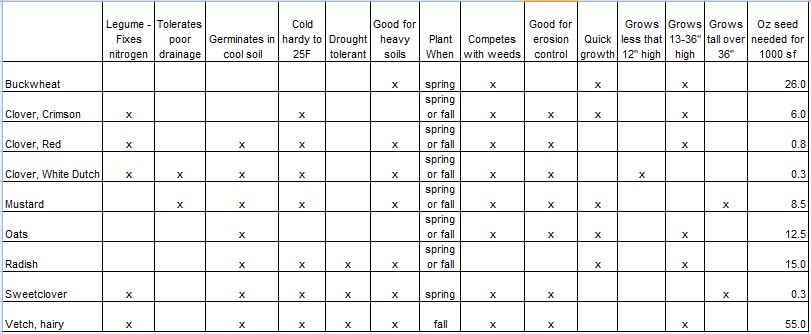Cover Crops
A cover crop is a crop planted with several goals; to manage soil fertility, soil quality, water, weeds, pests, diseases, biodiversity and wildlife in an ecological system that produces food.
-
They add nutrients to your soil.
-
They offer a stable environment for microbes and earthworms.
-
They reduce erosion.
-
They prevent heaving damage from freezing and thawing.
-
As roots decay, they loosen soil.
-
They shade weed seeds to prevent their germination.
The financial benefits of cover crops may not be easy to add to your vegetable garden savings, but the value is high due to creating an environment where plants thrive!
Sometimes cover crops are called green manure because they are tilled into the soil much the same as you would manure.
Cover crops improve soil quality by increasing organic matter levels through the input of the cover crop’s remnants over time. This increased soil organic matter enhances your soil structure, as well as the water and nutrient holding and capacity of soil.
It can also lead to increased soil carbon sequestration, which can help offset the rise in atmospheric carbon dioxide.
Although cover crops perform multiple functions simultaneously, they are often grown mostly for preventing soil erosion. Soil erosion can reduce the production of your garden. But a cover crop will slow down the impact of rainfall before it contacts the soil surface, preventing soil splashing and runoff. Additionally, the cover crop roots help anchor the soil in place.
Soil quality is enhanced so crops will flourish.
To apply a cover crop, work up the soil gently with a garden rake. Broadcast seed over the soil, and then rake it in. Raking establishes good soil-to-seed contact and protects the seed from birds. “Birds sometimes eat the seeds if they are too close to the surface,
If you decide to plant cover crops in the fall, be sure to allow them plenty of time to become established. “This means planting them 4 weeks before killing frosts
Cover crops are low-maintenance compared to most crops, but they still need some care. Mowing keeps large cover crops manageable. Be sure to water cover crops during times of drought.
Cut down your cover crops before they set seed and the top growth gets out of control. The best time to kill them is at flowering or when the seedheads emerge. Cut the plants at the base of the plant. You can mow cover crops with a lawn mower or a weed trimmer.
Wait a day or two to allow the leaves and stems dry down, and then till them in to the soil. It won’t take long before the vegetative growth decomposes.
After turning under a cover crop, wait 2 to 3 weeks before planting. The decomposition of the green material can tie up soil nitrogen.
Choosing a cover crop for your particular situation can be overwhelming with so many choices. This table may help. It shows the benefits and preferred growing environment of each type of cover crop.


